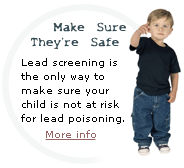Water
Because lead can still be found in plumbing systems, remember to use cold (not hot) water from the tap for cooking, food preparations, and to prepare infant formula. If the tap has not been used for 6 to 8 hours and you are not sure whether there is lead in your plumbing, run the water for 30 to 60 seconds before using it.
Home Renovations
If lead is present, or suspected to be present, you should not start renovation projects without getting the proper training or hiring trained contractors. Always assume any painted surface contains lead-based paint unless it has been tested by a properly certified inspector and found to be lead free. Always use lead safe work practices that minimize the spread of lead dust. Disturbing lead paint without using safe practices can release huge amounts of lead dust into your home. Vermont's EMP law does not require dust testing after a project; however you should consider having a lead dust test at the end of a renovation project if the work disturbs lead-painted surfaces. A lead dust clearance test offers the highest level of safety for children because if can determine if all lead dust has been property cleaned up and removed from the work area.
Lead dust testing can only be performed by someone licensed and certified as a lead inspector or lead dust sample technician. These are specialized certifications for the lead abatement industry and are different from the EMP certifications. Remember, under Vermont Law, the following
Hobbies or Work
If either involves use of; or exposure to lead, be especially careful to prevent exposure to children. Remember that children can be poisoned by taking lead home on your clothes or hands, or if they have access to the hobby area.
Porcelain and Ceramics
Lead as commonly added to ceramics and porcelain as both a fluxing agent and a pigment. Studies have shown that approximately 75% of the bathtubs in pre-1978 Vermont housing contain lead in the glaze. Lead can be found in both cast iron and steel tubs and in porcelain bathroom and kitchen sinks. Almost 40% of the tubs with lead in the glaze also had high levels of lead dust which means lead could end up in water or be ingested by children touching the glaze. The risk can be minimized by showering instead of bathing children, or by placing a plastic basin in the bottom of the tub and filling the basin with water instead of the tub.
Occasionally lead has been found in imported ceramic pottery, ceramic mugs, and imported china dishes as well. Some china dishes have been found with no lead in the ceramic, but the design on the dish was painted with lead paint. Acidic foods stored in contact with lead paint or lead glaze has been found to leach lead into the food. If you are unsure as to the lead content of a china dish or ceramic container, don't store food in it.
Keys
Lead is commonly added to the metal alloy in most keys to make the metal softer so it can be ground into the shape necessary for using it in a lock. Studies have shown that lead can be deposited on the hands from even minor handling of keys. Children should not be allowed to handle keys and should never be allowed to put them in their mouth. |


